浅谈市场营销中的定价策略正文
市场营销中的定价策略

市场营销中的定价策略定价是市场营销中至关重要的一部分,它直接影响着产品的销售和企业的利润。
通过合理的定价策略,企业可以在竞争激烈的市场中脱颖而出,实现销售和利润的最大化。
本文将通过介绍几种常见的定价策略,帮助读者更好地了解市场营销中的定价方法。
1. 成本导向定价策略成本导向定价策略是指根据产品的生产成本来确定价格。
这种定价策略主要适用于成本较为稳定、竞争激烈的市场。
企业通常会对产品的直接成本、间接成本以及利润率进行计算,然后将其加总得到最终的售价。
成本导向定价策略的优点是可以确保企业的成本得到覆盖,缺点是可能忽略了市场需求和竞争对手的定价策略。
2. 市场导向定价策略市场导向定价策略是指根据市场需求和竞争情况来确定价格。
企业需要研究市场,了解消费者对产品的需求弹性、竞争对手的定价策略等因素,以此为基础来确定最终的售价。
市场导向定价策略的优点是可以更好地适应市场需求,缺点是可能忽视了企业的成本和利润需求。
3. 价值导向定价策略价值导向定价策略是指根据产品的价值来决定价格,而不是仅仅考虑成本或市场情况。
企业需要通过市场调研和消费者洞察来确定产品的价值,然后根据价值来定价。
价值导向定价策略的优点是能够准确地反映产品的价值,缺点是在确定价值时可能存在主观性和误差。
4. 差异化定价策略差异化定价策略是指根据产品差异化程度来决定价格。
企业可以根据产品的特点、品质、功能等方面进行定价,以此来实现产品的差异化竞争优势。
差异化定价策略的优点是可以创造高附加值和较高利润,缺点是可能限制了产品的市场份额。
5. 促销定价策略促销定价策略是指为了促进销售而采取的一种定价方式。
企业可以通过定期折扣、打折优惠、满减、赠品等促销手段来吸引消费者,提高产品的销售量。
促销定价策略的优点是能够刺激市场需求,缺点是可能降低了产品的价值感知。
总结起来,市场营销中的定价策略有许多种,企业可以根据自身情况选择合适的策略。
无论是成本导向、市场导向、价值导向、差异化还是促销定价策略,都需要与市场和消费者的需求相匹配,同时确保企业的成本和利润得到合理的考虑。
市场营销策划中的定价策略

市场营销策划中的定价策略在市场营销领域,定价策略是一项关键性决策,直接影响到产品的竞争力和销售业绩。
通过合理的定价策略,企业能够实现利润最大化、市场份额的增加以及品牌形象的塑造。
本文将介绍市场营销策划中常用的定价策略,并探讨其在实际应用中的优势和限制。
一、成本导向定价策略成本导向定价策略是最常见的定价方式之一。
该策略以企业成本为基础,通过将一定的利润率加到产品成本上确定最终价格。
这种定价策略在简单的市场环境中应用广泛,无论是小型企业还是大型企业都可以使用。
优势在于简单易操作,有助于确保企业获得利润。
然而,成本导向定价也存在一些限制。
例如,它忽视了市场需求和竞争格局,可能无法满足消费者的价格敏感性和市场竞争的变化。
二、竞争导向定价策略在竞争激烈的市场环境中,企业常常采取竞争导向定价策略,以与竞争对手保持竞争力。
这种定价策略通常通过将价格设定在同行业中的平均水平或即将推出的竞争产品的价格之下来吸引消费者。
竞争导向定价策略的优势在于,它可以赢得市场份额,与竞争对手保持竞争力。
然而,过分依赖竞争导向定价可能会导致价格战,降低整个市场的利润空间。
三、价值导向定价策略价值导向定价策略注重产品和服务的唯一性和独特价值,以满足消费者对于高品质和高附加值的需求。
企业在制定价格时,从消费者的角度出发,考虑他们对产品的感知价值。
通过给予消费者感知价值与产品价格相匹配的价格,企业可以提高市场竞争力。
价值导向定价策略的优势在于能够实现较高的利润率和品牌形象的塑造。
然而,确定产品的感知价值可能会存在主观性和市场接受度的不确定性。
四、差异化定价策略差异化定价策略是根据产品的特征和不同市场细分的需求,为不同的消费者群体设定不同的价格。
这种策略可以依靠个性化服务和定制化产品满足不同消费者的需求,从而实现较高的价格和较高的利润率。
差异化定价策略的优势在于可以根据不同的市场细分实现最大化和差异化定价。
然而,差异化定价也需要企业进行精细的市场调研和分析,以确保不同价格的合理性和可接受性。
市场营销中的定价策略

市场营销中的定价策略定价是市场营销中的关键策略之一,它直接影响着产品的销售和企业的盈利能力。
正确的定价策略能够帮助企业实现竞争优势,提高市场份额,并长期保持盈利能力。
本文将探讨市场营销中的定价策略,包括定价目标、定价方法和定价策略的实施。
一、定价目标定价目标是企业制定定价策略的首要步骤。
企业制定定价目标时需考虑市场需求、成本和竞争对手的定价策略。
常见的定价目标包括市场份额增长、利润最大化、价格领导等。
例如,当企业希望抢占市场份额时,可以采用较低的价格策略,以吸引更多的消费者。
二、定价方法1. 成本加成法:根据产品成本加上一定的利润率来确定最终售价。
这种方法适用于成本结构相对稳定的产品。
2. 市场定价法:根据市场需求和竞争情况来制定价格。
常见的市场定价法有市场占有率定价和市场定价弹性法。
前者根据市场份额决定价格,后者根据价格弹性进行定价。
3. 价值定价法:根据产品所提供的价值来决定价格。
该方法将产品的售价与顾客对产品的价值进行联系,所以较为广泛应用。
三、定价策略的实施1. 价格策略多样化:企业在不同产品线或市场中可以采用不同的定价策略。
例如,高端产品可以采用溢价策略,中低端产品可以采用市场定价法。
2. 价格弹性定价:根据市场供求关系和价格弹性制定价格。
当市场需求较为弹性时,企业可以适度调整价格以吸引更多消费者。
3. 差异化定价:根据不同顾客群体的需求制定不同的价格。
例如,给予忠诚顾客折扣或推出优惠套餐。
4. 捆绑定价:将多款产品或服务捆绑在一起销售,以提高销售额和降低成本。
5. 促销定价:通过临时的折扣、赠品或打包销售等手段刺激需求,提高销售额。
6. 动态定价:根据市场需求和竞争情况及时调整价格。
企业可以使用市场调研和数据分析等工具来监测市场变化,灵活调整价格以适应市场需求。
总结起来,市场营销中的定价策略是一个复杂而关键的过程,需要考虑多个因素。
企业应根据不同的情况制定定价目标和方法,并选择适应的定价策略进行实施。
浅析市场营销中的定价策略
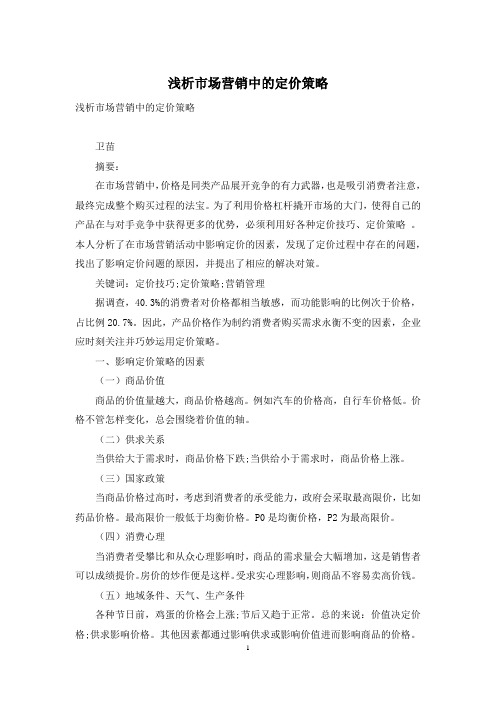
浅析市场营销中的定价策略浅析市场营销中的定价策略卫苗摘要:在市场营销中,价格是同类产品展开竞争的有力武器,也是吸引消费者注意,最终完成整个购买过程的法宝。
为了利用价格杠杆撬开市场的大门,使得自己的产品在与对手竞争中获得更多的优势,必须利用好各种定价技巧、定价策略。
本人分析了在市场营销活动中影响定价的因素,发现了定价过程中存在的问题,找出了影响定价问题的原因,并提出了相应的解决对策。
关键词:定价技巧;定价策略;营销管理据调查,40.3%的消费者对价格都相当敏感,而功能影响的比例次于价格,占比例20.7%。
因此,产品价格作为制约消费者购买需求永衡不变的因素,企业应时刻关注并巧妙运用定价策略。
一、影响定价策略的因素(一)商品价值商品的价值量越大,商品价格越高。
例如汽车的价格高,自行车价格低。
价格不管怎样变化,总会围绕着价值的轴。
(二)供求关系当供给大于需求时,商品价格下跌;当供给小于需求时,商品价格上涨。
(三)国家政策当商品价格过高时,考虑到消费者的承受能力,政府会采取最高限价,比如药品价格。
最高限价一般低于均衡价格。
P0是均衡价格,P2为最高限价。
(四)消费心理当消费者受攀比和从众心理影响时,商品的需求量会大幅增加,这是销售者可以成绩提价。
房价的炒作便是这样。
受求实心理影响,则商品不容易卖高价钱。
(五)地域条件、天气、生产条件各种节日前,鸡蛋的价格会上涨;节后又趋于正常。
总的来说:价值决定价格;供求影响价格。
其他因素都通过影响供求或影响价值进而影响商品的价格。
当商品价格过低时,为保护生产者的劳动积极性,政府会采取最低限价,例如药品价格。
最低高限价一般高于均衡价格。
二、定价策略存在的问题(一)价格欺诈价格就是经营者以不正当的价格手段,欺骗购买者使其经济利益受损的行为,或者经营者利用虚假或令人误解的价格条件,诱骗消费者或用户与其进行交易的行为。
企业对自己的商品制定获取合理的利润价格是合理的,也是应该的。
市场营销中的定价策略解析

市场营销中的定价策略解析在市场营销中,定价策略是企业成功的关键之一。
通过合理的定价策略,企业可以实现市场份额的增长、利润的最大化以及品牌价值的提升。
本文将深入探讨市场营销中的定价策略,并分析其对企业发展的影响。
一、定价策略的重要性定价策略在市场营销中的重要性不言而喻。
首先,定价直接影响企业的盈利能力。
过高的价格可能导致销量下降,而过低的价格则会影响企业的利润率。
其次,定价策略还可以塑造品牌形象和市场定位。
高价定位可以传递高品质、高档次的形象,而低价定位则强调性价比和大众化。
因此,制定合理的定价策略对企业的发展至关重要。
二、市场营销中的定价策略1.成本导向定价策略成本导向定价策略是最为常见的定价策略之一。
该策略基于企业的成本结构,通过将成本和利润率计入定价公式来制定产品价格。
这种策略适用于成本控制较为严格的行业,如制造业和零售业。
然而,成本导向定价策略忽略了市场需求和竞争状况,可能导致价格过高或过低,影响企业的市场竞争力。
2.竞争导向定价策略竞争导向定价策略是基于市场竞争状况来制定产品价格的策略。
企业通过分析竞争对手的定价策略和市场需求,决定自己的产品价格。
这种策略适用于竞争激烈的市场,可以帮助企业获取更多的市场份额。
然而,竞争导向定价策略可能导致价格战,降低整个行业的利润率,需要谨慎使用。
3.价值导向定价策略价值导向定价策略是基于产品或服务的价值来制定价格的策略。
企业通过提供独特的价值主张和差异化的产品特点,将产品价格与其价值联系起来。
这种策略适用于高附加值的产品或服务,可以提升企业的品牌形象和市场竞争力。
然而,价值导向定价策略需要企业提供真正的价值,否则可能导致市场反弹和品牌形象受损。
三、定价策略对企业发展的影响定价策略对企业发展具有重要影响。
首先,合理的定价策略可以帮助企业实现市场份额的增长。
通过制定具有竞争力的价格,企业可以吸引更多的消费者,提高产品销量。
其次,定价策略对企业的利润最大化至关重要。
市场营销中的价格战略

市场营销中的价格战略在竞争激烈的市场环境下,企业为了获取更多的市场份额和提高销售额,经常会采取价格战略。
价格战略是市场营销中的一种重要手段,它涉及到产品定价、折扣、促销等方面,广泛应用于不同行业。
本文将分析市场营销中的价格战略,以及其对企业发展和市场格局的影响。
一、价格战略的定义与特点价格战略是企业为了在市场中争夺份额而采取的定价策略。
它通常包括降低产品价格、提供折扣、实施促销活动等手段,以吸引消费者购买。
价格战略的特点主要有以下几点:1. 市场份额争夺:价格战略的目的在于通过降低价格来吸引消费者,从而增加销售额和市场份额。
2. 竞争压力:价格战略通常是竞争激烈的市场环境下才会出现的一种市场行为,企业往往在竞争对手之间争夺市场份额。
3. 利润压缩:降低产品价格可能导致利润率下降,企业需要在获得更多市场份额的同时保持可观的利润。
二、价格战略的类型价格战略可以根据不同的目标和策略分为多种类型。
以下是市场营销中常见的几种价格战略:1. 低价策略:企业降低产品价格,以低于竞争对手的价格吸引消费者。
这种策略通常用于新品上市或企业进入新市场时,以快速获得市场份额。
例如,抢占市场的手机品牌会在新品发布时采取低价策略。
2. 折扣策略:企业通过提供折扣来吸引消费者,增加销售额。
例如,打折季节或促销活动中商家常常推出折扣策略,吸引顾客购买。
3. 捆绑销售策略:企业将多个产品或服务组合在一起销售,以吸引顾客购买。
例如,电信运营商会将手机和通信套餐组合销售,以提高销售额。
4. 高价策略:某些高端品牌采取高价策略,通过在市场上建立高品质、高价值的形象,吸引特定消费者群体。
三、价格战略对企业发展的影响价格战略对企业发展有积极和消极的影响,具体表现如下:1. 提高市场份额:通过降低产品价格或提供折扣,企业可以吸引更多消费者,增加销售额和市场份额,进而扩大企业规模。
2. 增加竞争力:价格战略使企业在竞争中更具竞争力,尤其是在价格敏感的市场中。
市场营销策略的定价战略
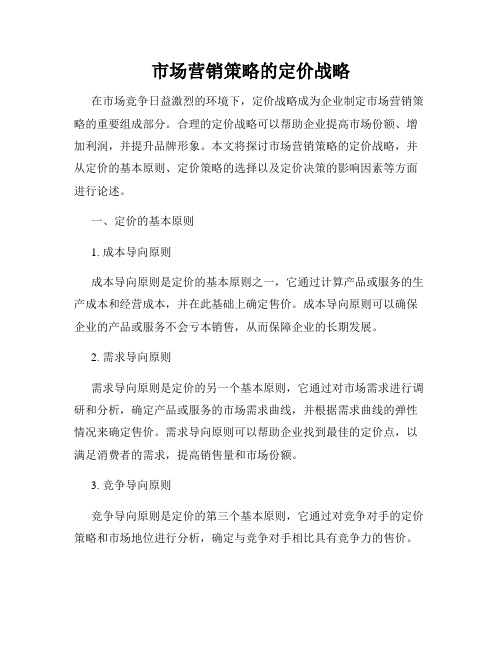
市场营销策略的定价战略在市场竞争日益激烈的环境下,定价战略成为企业制定市场营销策略的重要组成部分。
合理的定价战略可以帮助企业提高市场份额、增加利润,并提升品牌形象。
本文将探讨市场营销策略的定价战略,并从定价的基本原则、定价策略的选择以及定价决策的影响因素等方面进行论述。
一、定价的基本原则1. 成本导向原则成本导向原则是定价的基本原则之一,它通过计算产品或服务的生产成本和经营成本,并在此基础上确定售价。
成本导向原则可以确保企业的产品或服务不会亏本销售,从而保障企业的长期发展。
2. 需求导向原则需求导向原则是定价的另一个基本原则,它通过对市场需求进行调研和分析,确定产品或服务的市场需求曲线,并根据需求曲线的弹性情况来确定售价。
需求导向原则可以帮助企业找到最佳的定价点,以满足消费者的需求,提高销售量和市场份额。
3. 竞争导向原则竞争导向原则是定价的第三个基本原则,它通过对竞争对手的定价策略和市场地位进行分析,确定与竞争对手相比具有竞争力的售价。
竞争导向原则可以帮助企业在激烈的市场环境中保持竞争优势,吸引消费者选择自己的产品或服务。
二、定价策略的选择1. 高价策略高价策略适用于高端市场和高附加值产品或服务的定价。
高价策略可以提高产品或服务的形象和品牌价值,吸引目标消费者群体,并带来相对较高的利润。
然而,高价策略也存在吸引力较低、市场份额不大的风险。
2. 低价策略低价策略适用于大众市场和价格敏感型消费者群体。
低价策略可以通过价格优势吸引消费者,增加销售量和市场份额,并可能在后续通过提高附加值来提高利润。
然而,低价策略也可能带来较低的利润率和品牌形象的下降。
3. 中性价位策略中性价位策略适用于中高端市场和中等附加值产品或服务的定价。
中性价位策略可以在保持一定利润率的同时,兼顾消费者需求和品牌形象,实现市场份额和利润的双重增长。
三、定价决策的影响因素1. 市场需求和竞争情况市场需求的弹性和竞争对手的定价策略是影响定价决策的重要因素。
市场营销中的产品定价策略

市场营销中的产品定价策略在市场营销中,产品定价策略是企业成功的关键之一。
正确的定价策略可以帮助企业实现盈利最大化,提高市场份额,并与竞争对手保持竞争优势。
本文将探讨市场营销中的产品定价策略,并介绍几种常见的定价策略。
1. 市场定价策略市场定价策略是根据市场需求和竞争情况来制定产品价格的策略。
在制定市场定价策略时,企业需要考虑市场的需求弹性、竞争对手的价格策略以及产品的独特性等因素。
例如,如果市场需求弹性较高,企业可以采取低价策略来吸引更多的消费者;如果产品具有独特性,企业可以采取差异化定价策略来获取更高的利润。
2. 成本定价策略成本定价策略是以产品成本为基础,确定产品价格的策略。
在制定成本定价策略时,企业需要考虑生产成本、销售费用以及期望的利润率等因素。
常见的成本定价策略包括全成本定价和边际成本定价。
全成本定价是将所有成本包括在产品价格中,以确保企业能够覆盖所有的成本;而边际成本定价则是根据每单位产品的边际成本来确定产品价格,以确保企业能够获得足够的利润。
3. 市场份额定价策略市场份额定价策略是以企业在市场中的份额为基础,确定产品价格的策略。
在制定市场份额定价策略时,企业需要考虑自身的市场地位以及竞争对手的定价策略。
常见的市场份额定价策略包括市场领导者定价和市场追随者定价。
市场领导者定价是指市场份额较大的企业通过制定较高的产品价格来获取更高的利润;而市场追随者定价则是指市场份额较小的企业通过制定较低的产品价格来吸引更多的消费者。
4. 价值定价策略价值定价策略是根据产品的价值来确定产品价格的策略。
在制定价值定价策略时,企业需要考虑产品的独特性、品牌形象以及消费者对产品的感知价值等因素。
常见的价值定价策略包括高端定价和低端定价。
高端定价是指企业通过提供高品质的产品和服务来赢得消费者的信任,并以较高的价格来获取利润;而低端定价则是指企业通过提供廉价的产品和服务来吸引更多的消费者。
总结起来,市场营销中的产品定价策略是企业实现盈利最大化和保持竞争优势的重要手段。
市场营销中的定价策略

市场营销中的定价策略在市场营销中,定价策略是企业制定产品或服务价格的重要决策之一。
恰当的定价策略不仅能够帮助企业实现良好的营收和利润,还能够塑造品牌形象、与竞争对手竞争并满足市场需求。
本文将介绍市场营销中常见的定价策略,以及如何根据市场情况选择适合的定价策略。
一、成本导向定价策略1.全成本定价:这是最简单的定价策略之一,企业根据产品生产或服务提供的成本加上所需的利润率来确定价格。
这种策略适用于市场对价格敏感且竞争激烈的产品或服务。
2.成本加成定价:在这种策略下,企业会根据产品或服务单位成本加上额外的费用(如销售费用、宣传费用等)来确定最终价格。
这种策略可确保企业覆盖所有成本,并提供一定的利润。
二、需求导向定价策略1.市场定价:企业在制定价格时,会根据市场需求和供求关系来决定最终价格。
当市场需求高涨时,企业可以设置较高的价格以获取更高的利润。
相反,当市场需求不足时,企业可能会降低价格以吸引更多的消费者。
2.动态定价:在这种策略下,企业会根据市场环境和竞争对手的定价策略而灵活调整价格。
通过实时监控市场变化,企业可以根据需求和竞争情况做出适当的定价调整。
三、竞争导向定价策略1.低价策略:企业通过降低价格来吸引消费者,以争夺市场份额。
低价策略适用于价格敏感性较高的市场或竞争激烈的行业。
2.高价策略:企业通过定价较高来传递产品或服务的高品质形象,以吸引愿意为高品质产品付费的消费者。
高价策略适用于高端市场或独特产品的销售。
四、市场定位导向定价策略1.折扣策略:企业通过给予折扣或促销活动来吸引消费者,提高产品的销售量和市场份额。
2.差异化定价:企业根据产品或服务的特点,通过设定不同的价格来满足不同消费者群体的需求。
这种策略可以根据产品或服务的差异化程度设定不同的价格。
无论采用哪种定价策略,企业都应该根据市场需求、产品定位、竞争环境和目标利润来综合考虑。
此外,企业还需要不断监测市场变化,灵活地调整定价策略,以适应快速变化的市场需求。
市场营销策划中的市场营销定价和定价策略

市场营销策划中的市场营销定价和定价策略市场营销定价是市场营销策划中的一个重要环节,它直接关系到企业产品在市场中的销售情况和企业利润的实现。
本文将围绕市场营销定价及其策略展开论述,探讨如何在市场营销活动中制定合理的定价策略。
一、市场营销定价的定义与重要性市场营销定价是指企业在开展市场营销活动时所制定的产品价格。
它不仅是市场营销策划的一个重要组成部分,也是企业获取利润和维持市场竞争力的基础。
合理的定价能够增加产品的市场竞争力,稳定企业的盈利能力,并且对消费者产生一定的吸引力,从而促进销售和品牌建设。
二、市场营销定价的原则和方法在制定市场营销定价策略时,企业应考虑以下原则:1.成本原则:市场营销定价应基于产品生产成本和市场竞争情况,以确保企业能够实现盈利。
2.需求原则:市场营销定价要根据市场需求和消费者的支付能力来确定,以满足消费者对产品价格的接受度。
3.竞争原则:市场营销定价也要参考竞争对手的定价策略,避免过高或过低的价格,以避免市场份额的损失。
4.市场定位原则:企业在制定市场营销定价时,应根据产品的定位策略来设定价格,以保持品牌形象和市场竞争力。
市场营销定价的方法主要有三种:1.成本加成法:在产品生产成本基础上加上一定的利润,确定产品的最低销售价格。
2.竞争定价法:根据竞争对手的定价策略来制定自己的产品价格,使产品价格具有竞争力。
3.价值定价法:根据产品的独特价值和对消费者的需求程度,以及消费者对产品的价格敏感度,确定产品的价格。
三、市场营销定价策略市场营销定价策略是指企业在制定定价时所采用的具体方法和手段。
以下是几种常用的市场营销定价策略:1.高价策略:高价策略适用于高端市场,通过提高产品价格来塑造产品的高档形象,吸引那些愿意为高品质产品买单的消费者。
2.低价策略:低价策略适用于市场占有率相对较低的企业或新产品,通过低价促销来吸引消费者,增加销售数量。
3.差异化定价策略:差异化定价策略是根据不同的市场需求,设置不同的定价,以满足不同消费者群体的需求。
市场营销策略中的产品定价策略

市场营销策略中的产品定价策略市场竞争激烈的今天,产品的定价策略成为企业在市场营销中必须认真考虑和制定的一项重要策略。
恰当的产品定价策略不仅可以帮助企业提高市场占有率,还可以提高企业的利润和品牌形象。
然而,如何制定适合自己企业的产品定价策略却并非易事,本文将探讨在市场营销中的产品定价策略,并提出一些建议。
一、市场定位决定产品定价市场定位是企业在市场营销中的核心问题之一。
企业进行市场定位时需要考虑产品的定位、目标市场、竞争对手等因素。
产品定价策略应该与市场定位相匹配,以满足目标市场的需求,并与竞争对手形成差异化。
市场定位决定了企业对产品定价的定位。
如果产品被定位为高端产品,那么企业可以采用高价策略,以传递高品质、高附加值的形象。
相反,如果产品被定位为大众消费品,那么企业可以采用低价策略,以追求市场份额和规模效应。
二、成本导向和价值导向的平衡在制定产品定价策略时,企业需要在成本导向和价值导向之间找到平衡点。
成本导向主要关注产品的制造成本和运营成本,企业希望通过定价来保证产品的盈利能力。
价值导向则强调产品的附加值和市场认可度,企业希望通过定价来传递产品的价值和品质。
对于高成本产品,企业可以采取高价格策略,以保持盈利能力。
但同时也需要考虑市场的接受程度,避免过高的价格导致市场回报不佳。
对于低成本产品,企业可以采取低价策略,以迅速占领市场份额。
但需要注意的是,低价并不意味着低品质,企业仍需要传递产品的价值和品质。
三、不同定价策略的应用场景在市场营销中,存在着多种不同的产品定价策略,企业可以根据自身情况和市场需求选择合适的策略。
1.市场份额策略市场份额策略是指企业通过低价来迅速占领市场份额。
这种策略适用于新产品、新市场或者市场份额较小的企业。
通过低价策略可以吸引大量消费者,从而建立起客户基础,增强品牌影响力。
2.差异化策略差异化策略是指企业通过产品的差异化和附加值来实现定价竞争优势。
通过提供独特的产品特点、个性化的服务或者创新的设计,企业可以与竞争对手形成差异化。
市场营销中的产品定价策略
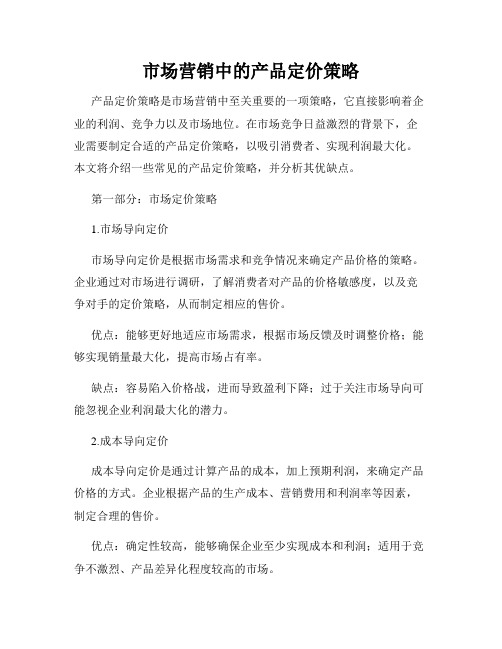
市场营销中的产品定价策略产品定价策略是市场营销中至关重要的一项策略,它直接影响着企业的利润、竞争力以及市场地位。
在市场竞争日益激烈的背景下,企业需要制定合适的产品定价策略,以吸引消费者、实现利润最大化。
本文将介绍一些常见的产品定价策略,并分析其优缺点。
第一部分:市场定价策略1.市场导向定价市场导向定价是根据市场需求和竞争情况来确定产品价格的策略。
企业通过对市场进行调研,了解消费者对产品的价格敏感度,以及竞争对手的定价策略,从而制定相应的售价。
优点:能够更好地适应市场需求,根据市场反馈及时调整价格;能够实现销量最大化,提高市场占有率。
缺点:容易陷入价格战,进而导致盈利下降;过于关注市场导向可能忽视企业利润最大化的潜力。
2.成本导向定价成本导向定价是通过计算产品的成本,加上预期利润,来确定产品价格的方式。
企业根据产品的生产成本、营销费用和利润率等因素,制定合理的售价。
优点:确定性较高,能够确保企业至少实现成本和利润;适用于竞争不激烈、产品差异化程度较高的市场。
缺点:忽视了市场需求和竞争情况对产品价格的影响;无法灵活调整售价以适应市场变化。
第二部分:产品定价策略1.低价策略低价策略是指企业以低于市场平均价格的价格出售产品,以吸引消费者并提高市场份额。
这种策略常见于新进入市场的企业或者企业推出新产品时。
优点:能够吸引更多的消费者,打开市场;增加消费者对产品的认可度和忠诚度。
缺点:降低了企业的利润空间;可能导致产品品牌形象受损。
2.高价策略高价策略是指企业以高于市场平均价格的价格销售产品,以突出产品的高品质和独特性。
这种策略常见于高端品牌或者市场上稀缺的产品。
优点:能够创造高品质的产品形象,提升消费者对产品的价值认可;实现高利润和品牌溢价。
缺点:有可能限制了产品的潜在消费群体;过高的价格可能导致市场需求下降。
3.捆绑定价策略捆绑定价策略是指将多个产品或服务捆绑在一起,以较低的总价销售。
这种策略可以增加产品的附加值,提高消费者购买的动力。
市场营销中的产品定价策略
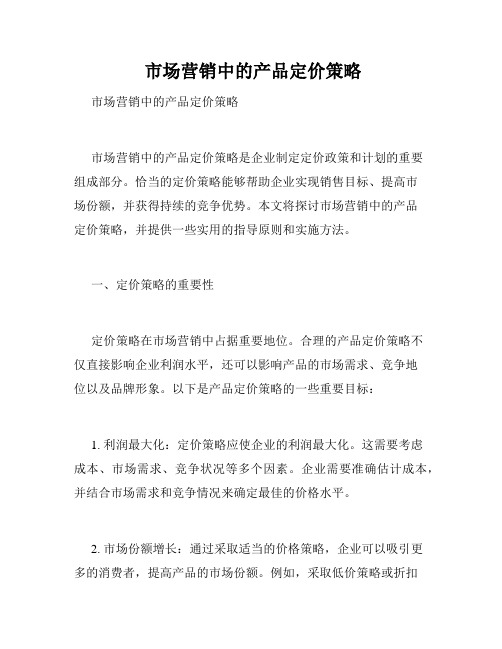
市场营销中的产品定价策略市场营销中的产品定价策略市场营销中的产品定价策略是企业制定定价政策和计划的重要组成部分。
恰当的定价策略能够帮助企业实现销售目标、提高市场份额,并获得持续的竞争优势。
本文将探讨市场营销中的产品定价策略,并提供一些实用的指导原则和实施方法。
一、定价策略的重要性定价策略在市场营销中占据重要地位。
合理的产品定价策略不仅直接影响企业利润水平,还可以影响产品的市场需求、竞争地位以及品牌形象。
以下是产品定价策略的一些重要目标:1. 利润最大化:定价策略应使企业的利润最大化。
这需要考虑成本、市场需求、竞争状况等多个因素。
企业需要准确估计成本,并结合市场需求和竞争情况来确定最佳的价格水平。
2. 市场份额增长:通过采取适当的价格策略,企业可以吸引更多的消费者,提高产品的市场份额。
例如,采取低价策略或折扣活动可以吸引价格敏感的消费者,从而增加销售量并扩大市场份额。
3. 竞争优势:定价策略还可以为企业带来竞争优势。
通过选择与竞争对手不同的定价策略,企业可以在市场中树立独特的品牌形象,并获得竞争优势。
二、常见的定价策略在市场营销中,存在多种常见的产品定价策略。
以下是一些常见的定价策略及其适用场景:1. 市场导向定价策略:基于市场需求和竞争情况来确定产品价格。
通过对市场进行调研和分析,企业可以了解市场需求和竞争情况,从而制定适应市场的价格策略。
2. 成本导向定价策略:基于产品的成本来确定价格。
企业需要考虑生产成本、销售费用和利润率等因素,以确保产品能够覆盖成本并获得合理的利润。
3. 竞争导向定价策略:基于竞争对手的定价来确定价格。
企业可以选择与竞争对手相同或略高或略低的价格水平,以获得竞争优势或维持市场地位。
4. 市场细分定价策略:根据不同市场细分群体的需求和支付能力来制定不同的价格策略。
企业可以根据市场细分结果,对不同群体的消费者提供不同价格和产品组合。
三、实施产品定价策略的方法在实施产品定价策略时,企业可以考虑以下几种方法:1. 定价的弹性分析:通过分析市场对价格变化的反应程度,企业可以确定产品的定价弹性。
市场营销策划中的价格策略
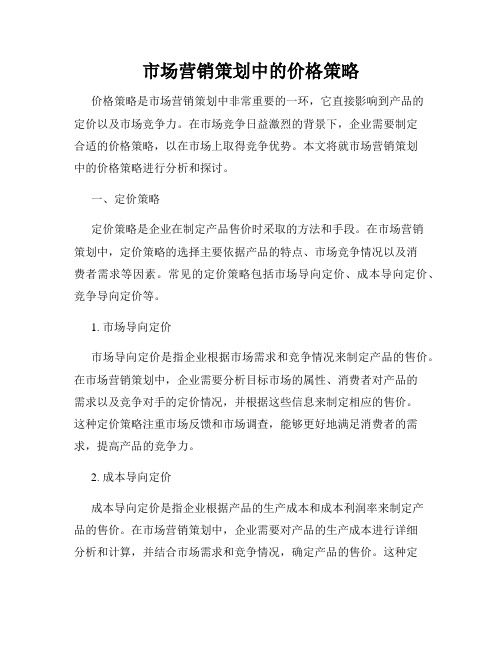
市场营销策划中的价格策略价格策略是市场营销策划中非常重要的一环,它直接影响到产品的定价以及市场竞争力。
在市场竞争日益激烈的背景下,企业需要制定合适的价格策略,以在市场上取得竞争优势。
本文将就市场营销策划中的价格策略进行分析和探讨。
一、定价策略定价策略是企业在制定产品售价时采取的方法和手段。
在市场营销策划中,定价策略的选择主要依据产品的特点、市场竞争情况以及消费者需求等因素。
常见的定价策略包括市场导向定价、成本导向定价、竞争导向定价等。
1. 市场导向定价市场导向定价是指企业根据市场需求和竞争情况来制定产品的售价。
在市场营销策划中,企业需要分析目标市场的属性、消费者对产品的需求以及竞争对手的定价情况,并根据这些信息来制定相应的售价。
这种定价策略注重市场反馈和市场调查,能够更好地满足消费者的需求,提高产品的竞争力。
2. 成本导向定价成本导向定价是指企业根据产品的生产成本和成本利润率来制定产品的售价。
在市场营销策划中,企业需要对产品的生产成本进行详细分析和计算,并结合市场需求和竞争情况,确定产品的售价。
这种定价策略能够保证企业的利润,但可能忽视了市场需求的变化和竞争对手的定价策略,因此需要谨慎使用。
3. 竞争导向定价竞争导向定价是指企业根据竞争对手的定价情况来制定产品的售价。
在市场营销策划中,企业需要详细了解竞争对手的定价策略和市场表现,然后制定具有竞争优势的定价策略。
这种定价策略可以有效地提高企业的市场占有率和盈利能力。
二、价格战略价格战略是企业在市场竞争中通过调整价格来达到某种目标的策略。
在市场营销策划中,企业需要根据市场情况和竞争对手的动态来制定适合的价格战略,以提升市场地位和盈利能力。
常见的价格战略包括差异化定价、折扣定价和促销定价等。
1. 差异化定价差异化定价是指企业根据产品的差异和独特价值来制定不同的价格。
在市场营销策划中,企业需要通过市场调研和分析,找到产品的差异化特点,并根据这些特点来制定相应的价格。
市场营销中的定价策略
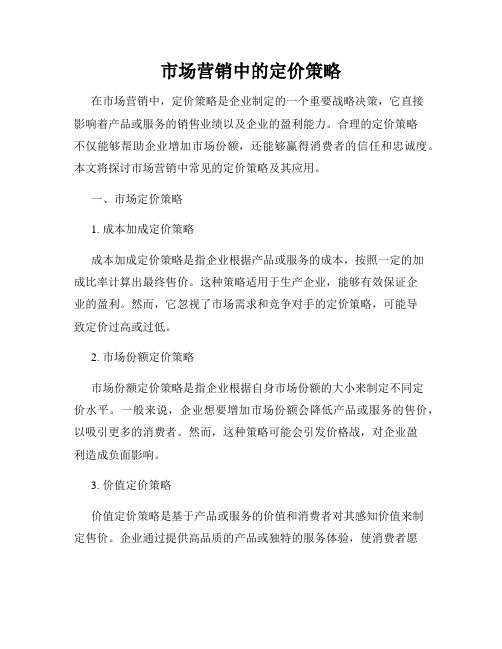
市场营销中的定价策略在市场营销中,定价策略是企业制定的一个重要战略决策,它直接影响着产品或服务的销售业绩以及企业的盈利能力。
合理的定价策略不仅能够帮助企业增加市场份额,还能够赢得消费者的信任和忠诚度。
本文将探讨市场营销中常见的定价策略及其应用。
一、市场定价策略1. 成本加成定价策略成本加成定价策略是指企业根据产品或服务的成本,按照一定的加成比率计算出最终售价。
这种策略适用于生产企业,能够有效保证企业的盈利。
然而,它忽视了市场需求和竞争对手的定价策略,可能导致定价过高或过低。
2. 市场份额定价策略市场份额定价策略是指企业根据自身市场份额的大小来制定不同定价水平。
一般来说,企业想要增加市场份额会降低产品或服务的售价,以吸引更多的消费者。
然而,这种策略可能会引发价格战,对企业盈利造成负面影响。
3. 价值定价策略价值定价策略是基于产品或服务的价值和消费者对其感知价值来制定售价。
企业通过提供高品质的产品或独特的服务体验,使消费者愿意为其付出更高的价格。
这种策略适用于高端产品或服务,但需要企业具备在市场中创造独特价值的能力。
4. 定价分割策略定价分割策略是将市场分为不同的细分市场,根据每个细分市场的需求和支付能力制定不同的售价。
这种策略可以满足不同消费者的需求,并最大化企业收益。
然而,对细分市场的准确划分和对定价的管理需要企业具备一定的市场调研和分析能力。
二、定价策略的应用1. 新产品定价针对新产品的定价,企业可以选择市场平均价格,使产品定价具备竞争力并获得市场份额;或者通过较低的价格来吸引消费者,并逐步提高价格,以建立产品的品牌形象和市场认可度。
2. 价格捆绑销售价格捆绑销售是将多个相关产品或服务以较低的总价一起销售,吸引消费者的购买欲望。
这种策略可以增加产品的附加值,提高销售量,同时也可以帮助企业进一步了解消费者需求。
3. 差异化定价差异化定价是根据不同的目标市场或消费者群体,制定不同的售价。
例如,企业可以根据地域、消费能力、使用频率等因素来进行定价。
市场营销中的定价策略探讨
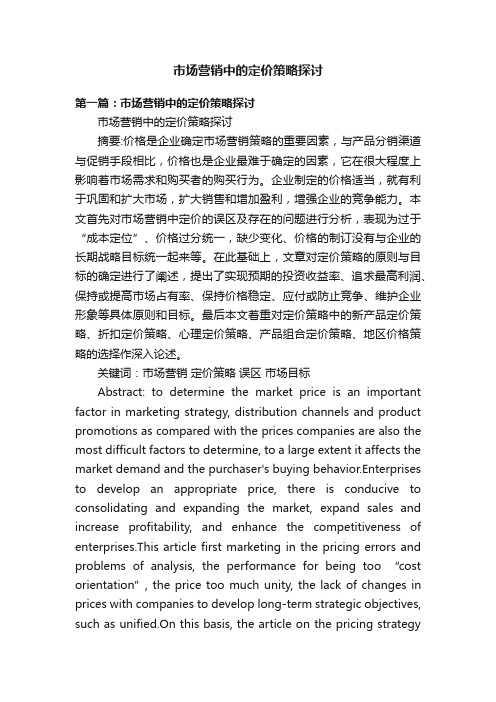
市场营销中的定价策略探讨第一篇:市场营销中的定价策略探讨市场营销中的定价策略探讨摘要:价格是企业确定市场营销策略的重要因素,与产品分销渠道与促销手段相比,价格也是企业最难于确定的因素,它在很大程度上影响着市场需求和购买者的购买行为。
企业制定的价格适当,就有利于巩固和扩大市场,扩大销售和增加盈利,增强企业的竞争能力。
本文首先对市场营销中定价的误区及存在的问题进行分析,表现为过于“成本定位”、价格过分统一,缺少变化、价格的制订没有与企业的长期战略目标统一起来等。
在此基础上,文章对定价策略的原则与目标的确定进行了阐述,提出了实现预期的投资收益率、追求最高利润、保持或提高市场占有率、保持价格稳定、应付或防止竞争、维护企业形象等具体原则和目标。
最后本文着重对定价策略中的新产品定价策略、折扣定价策略、心理定价策略、产品组合定价策略、地区价格策略的选择作深入论述。
关键词:市场营销定价策略误区市场目标Abstract: to determine the market price is an important factor in marketing strategy, distribution channels and product promotions as compared with the prices companies are also the most difficult factors to determine, to a large extent it affects the market demand and the purchaser's buying behavior.Enterprises to develop an appropriate price, there is conducive to consolidating and expanding the market, expand sales and increase profitability, and enhance the competitiveness of enterprises.This article first marketing in the pricing errors and problems of analysis, the performance for being too “cost orientation”, the price too much unity, the lack of ch anges in prices with companies to develop long-term strategic objectives, such as unified.On this basis, the article on the pricing strategyof the principles and objectives have been identified on the proposed investment to achieve the desired yield, the pursuit of maximum profits, and maintain or increase market share and maintain price stability, to cope with or prevent competition, and maintenance of enterprise the image of the specific principles and objectives.Finally, this paper focuses on pricing strategies of new product pricing strategies, discount pricing strategy, psychological pricing strategy, product mix pricing strategies, pricing strategies areas for in-depth discussion of the choice.Key words: pricing strategy marketing target market errors 引言在市场经济中,价格竞争是一种重要的竞争形式。
市场营销中的定价策略研究
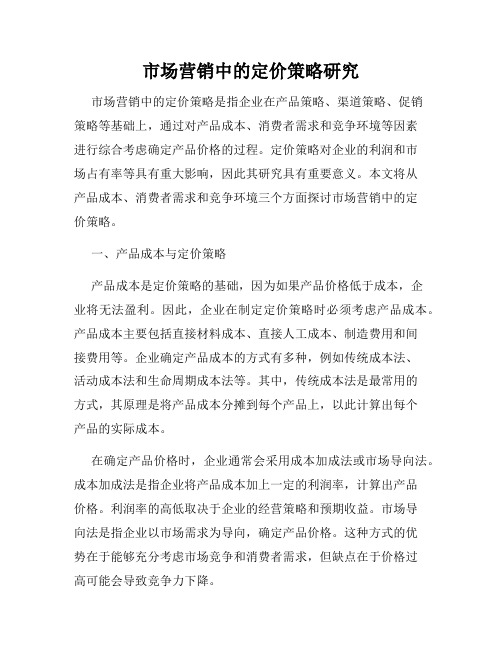
市场营销中的定价策略研究市场营销中的定价策略是指企业在产品策略、渠道策略、促销策略等基础上,通过对产品成本、消费者需求和竞争环境等因素进行综合考虑确定产品价格的过程。
定价策略对企业的利润和市场占有率等具有重大影响,因此其研究具有重要意义。
本文将从产品成本、消费者需求和竞争环境三个方面探讨市场营销中的定价策略。
一、产品成本与定价策略产品成本是定价策略的基础,因为如果产品价格低于成本,企业将无法盈利。
因此,企业在制定定价策略时必须考虑产品成本。
产品成本主要包括直接材料成本、直接人工成本、制造费用和间接费用等。
企业确定产品成本的方式有多种,例如传统成本法、活动成本法和生命周期成本法等。
其中,传统成本法是最常用的方式,其原理是将产品成本分摊到每个产品上,以此计算出每个产品的实际成本。
在确定产品价格时,企业通常会采用成本加成法或市场导向法。
成本加成法是指企业将产品成本加上一定的利润率,计算出产品价格。
利润率的高低取决于企业的经营策略和预期收益。
市场导向法是指企业以市场需求为导向,确定产品价格。
这种方式的优势在于能够充分考虑市场竞争和消费者需求,但缺点在于价格过高可能会导致竞争力下降。
二、消费者需求与定价策略消费者需求是制定定价策略时必须考虑的重要因素。
消费者需求的高低将直接影响产品价格的高低。
消费者需求的测量方式包括市场调查、竞争情况分析和市场定位等。
在确定产品价格时,企业应该根据消费者需求采用不同的定价策略。
一般来说,如果产品需求弹性较高,企业应该采用弹性定价策略。
弹性定价策略是指企业在市场上根据需求弹性变化和竞争状况等情况,动态调整产品价格的策略。
如果产品需求弹性较低,企业应该采用刚性定价策略。
刚性定价策略是指企业在市场上根据自身成本、价格水平和产品差异化等因素,稳定地设置产品价格的策略。
三、竞争环境与定价策略竞争环境是制定定价策略时必须考虑的另一个重要因素。
市场上存在的竞争力量将直接影响产品价格的确定。
市场营销策划的定价策略
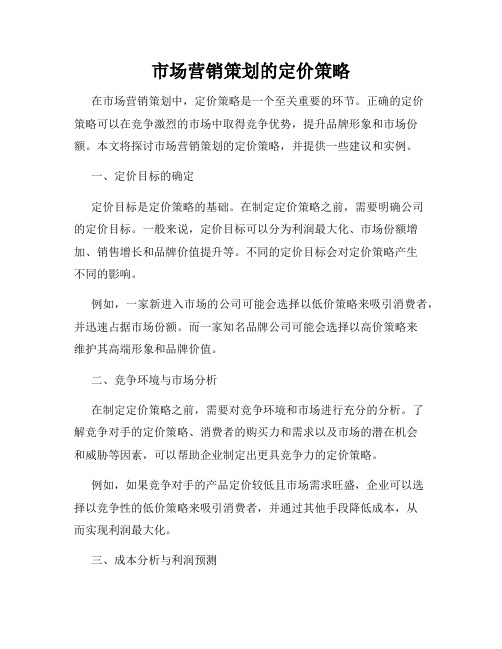
市场营销策划的定价策略在市场营销策划中,定价策略是一个至关重要的环节。
正确的定价策略可以在竞争激烈的市场中取得竞争优势,提升品牌形象和市场份额。
本文将探讨市场营销策划的定价策略,并提供一些建议和实例。
一、定价目标的确定定价目标是定价策略的基础。
在制定定价策略之前,需要明确公司的定价目标。
一般来说,定价目标可以分为利润最大化、市场份额增加、销售增长和品牌价值提升等。
不同的定价目标会对定价策略产生不同的影响。
例如,一家新进入市场的公司可能会选择以低价策略来吸引消费者,并迅速占据市场份额。
而一家知名品牌公司可能会选择以高价策略来维护其高端形象和品牌价值。
二、竞争环境与市场分析在制定定价策略之前,需要对竞争环境和市场进行充分的分析。
了解竞争对手的定价策略、消费者的购买力和需求以及市场的潜在机会和威胁等因素,可以帮助企业制定出更具竞争力的定价策略。
例如,如果竞争对手的产品定价较低且市场需求旺盛,企业可以选择以竞争性的低价策略来吸引消费者,并通过其他手段降低成本,从而实现利润最大化。
三、成本分析与利润预测定价策略的制定需要基于成本分析和利润预测。
了解产品的生产成本、运营成本和销售成本等,可以帮助企业制定出合理的定价策略,并预测未来的利润状况。
企业可以通过成本加成法、市场定价法和边际成本法等方法进行成本分析和定价决策。
同时还需要考虑到产品的竞争力、市场需求和消费者购买力等因素,以确保产品定价的合理性和适应性。
四、差异化定价与定价弹性差异化定价是一种常用的定价策略,即根据不同的客户群体或市场段进行定价。
通过差异化定价,企业可以更好地满足不同消费者的需求和支付能力,并提高产品的竞争力和盈利能力。
另外,定价弹性也是制定定价策略时需要考虑的因素。
定价弹性是指价格变动对需求变动的敏感度。
了解产品的定价弹性可以帮助企业评估价格调整的风险和机会,从而制定出更为合理和有效的定价策略。
五、市场营销策略与定价策略的协调定价策略需要与市场营销策略相互协调。
浅谈市场营销中的定价策略正文
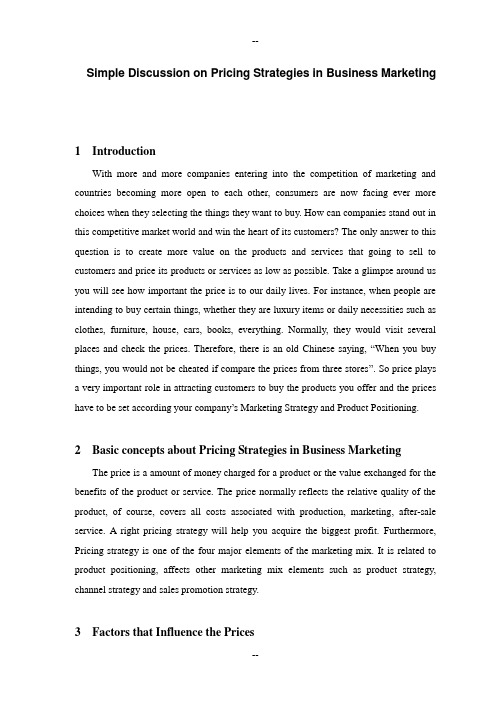
Simple Discussion on Pricing Strategies in Business Marketing1 IntroductionWith more and more companies entering into the competition of marketing and countries becoming more open to each other, consumers are now facing ever more choices when they selecting the things they want to buy. How can companies stand out in this competitive market world and win the heart of its customers? The only answer to this question is to create more value on the products and services that going to sell to customers and price its products or services as low as possible. Take a glimpse around us you will see how important the price is to our daily lives. For instance, when people are intending to buy certain things, whether they are luxury items or daily necessities such as clothes, furniture, house, cars, books, everything. Normally, they would visit several places and check the prices. Therefore, there is an old Chinese saying, “When you buy things, you would not be cheated if compare the prices from three stores”. So price plays a very important role in attracting customers to buy the products you offer and the prices have to be set according your company’s Marketing Strategy and Product Positioning.2 Basic concepts about Pricing Strategies in Business MarketingThe price is a amount of money charged for a product or the value exchanged for the benefits of the product or service. The price normally reflects the relative quality of the product, of course, covers all costs associated with production, marketing, after-sale service. A right pricing strategy will help you acquire the biggest profit. Furthermore, Pricing strategy is one of the four major elements of the marketing mix. It is related to product positioning, affects other marketing mix elements such as product strategy, channel strategy and sales promotion strategy.3 Factors that Influence the Prices3.1 Inner Factors that Influence the PricesThere are so many factors existing inside an organization that affect the setting of price and all of them can hardly be overcome, such as pricing target, raw material cost, production cost, transportation cost, sales cost. Though these factors are unremovable, we can maximize company’s profits by reducing the negative impact of these factors, optimizing the use of resources and lowering the relevant costs or finding alternatives. 3.1.1 Organization PolicyEvery organization has its own policies, such as product policy, quality policy, environment policy, enterprise culture, etc. These policies, in the end would affect organization’s pricing strategy to some extent. For example, a pump manufacturer promises its customers that if the customer found the pump purchased from the company has any problems within five years they would replace the parts free of charge for its customers and send the repairmen to the application spot within 72 hours after receiving the call from the customer. This is a good phenomenon and the customer would be very satisfied because of good after-sale services. However, manufacturer, of cause had already added all the costs associated with replaced parts and quick after-sale services to the price of product itself before he promised his customers for the simple reason that the cost for replacing defective parts and cost for sending his repairmen to customer’ side could be much more expensive than the total price of pump itself. In other words, It is customer himself who paid for the replaced parts and quick services and the product price of this manufacturer is much higher than other manufacturers or agents due to free parts and quick services that manufacturer provides.3.1.2 Pricing TargetTo survive in today’s highly competitive marketplace, companies need pricing objectives that are specific, attainable, and measurable. Realistic pricing goals then need periodic monitoring to determine the effectiveness of the company’s strategy. Generally speaking, the pricing objectives can be divided into two categories: profit-orientated objectives, sales-oriented objectives. Therefore, profit-oriented pricing objectives include profit maximization, satisfactory profits, and target return on investment.Profit maximization means setting price so that total revenue is as large as possiblerelative to total costs, in other words, trying to make as much money as possible. In reality, profit maximization does not always signify unreasonably high prices because when an organization sets prices, the firm often prices its products based upon the type of competitive environment it faces, such as being in a monopoly position (being the only seller) or selling in a severely competitive marketplace.Satisfactory profits are a reasonable level of profits. Rather than maximizing profits, many organizations strive for profits that are satisfactory to the stockholders and management, in other words, a level of profits consistent with the level of risk an organization faces. Typical example of Satisfactory profits is: In some countries including China , in order to maximize profits the shop owner would keep his store open for 24 hours a day and 7 days a week, however, in some other countries, the shop owner may not want to work that hard and might be satisfied with less profit.The most common profit objective is a target return on investment (ROI), sometimes called the firm ’s return on total assets. ROI measures the overall effectiveness of management in generating profits with its available assets. The higher the firm ’s return on investment, the better off the firm is. Many companies- including GENERAL MOTERS, VOLVE, BOCSH-- use target return on investment as their main pricing goal.Return on investment is calculated as follows:Return on investment=Assuming that in 2004 Johnson Controls had assets of $4.5 million, net profits of $550,000, and target ROI of 10 percent . This was the actual ROI: 550,0004,500,000As you can see from the above, the ROI for Johnson Controls exceeds its target, which indicates that the company prospered in 2004. In practice, a company with target ROI can predetermine its desired level of profitability. The marketing manager can use the standard such as 10 percent or 20 percent to determine whether a particular Pricing and Marketing Strategy is feasible. In addition, however, the manager must weigh the riskROI= Net profits after taxesTotal assets= 12.2 percentof a given strategy even if the return is in the acceptable range.Sales-oriented pricing objective was based either on market share or on dollar or unit sales. Many companies believe that maintaining or increasing market share is an indicator of the effectiveness of their marketing mix. Large market share indeed often meant higher profits, so many companies would like to do their best to increase their market share by reducing product price and offering better products and services. Although companies who apply sales-oriented pricing objective may earn less profits for each product, they can make up the loss of reduced prices by selling more products and services to customers, The more products, services you sell to your customers, the more profits you earn and the bigger market share you occupy.3.1.3 Research and Development CostR&D cost is a big factor that influences the pricing setting, in modern society, innovation and uniqueness plays a big part in attracting customers to buy the commodities you sell and price setting. The quicker you can innovate a new product and launch the product on to market, the more money you can earn and quicker return you can get. Of cause, the more complicated the product is, the quicker you want to get your products onto the market, the more cost you will have to spend on the research and development of new products, in the end, all of these costs have to be added into the final prices of new product and the costs have to be born by end customers.3.1.4 Production CostProduction cost is direct cost that the manufacturers and service providers have to pay, including the cost of raw material, machines, equipments, resources, labor, management, building, etc. The production cost is the direct cost and biggest cost that product or service providers have to bear. So the production cost is the biggest factor that affects the setting of price.3.1.5 Sales CostSales costs include making sales planning, hiring sales staff and selecting sales channel, hiring distributors or even setting a sales office abroad, etc. The sales processes can be very complicated and expensive. In order to lower the cost as much as possible and win bigger profits, to select right sales channel and sales staff are very important.3.2 External Factors that Influence the Prices3.2.1 Government PolicyGovernment policy has big impact on price setting, even affect the sales of the products. For instance, if government increases taxes or customs tariffs on certain commodities, or put a constraint on certain products, the sales and prices of the commodities would be greatly affected. Although in modern world, the countries are becoming more open to each other, the rate discriminations and unfairness are still existing, government policy changes frequently in some countries. So when an organization is planning to export their commodities to other country, or import the products from overseas, it is very important to make sure the situation of the country that the firm is going to deal with is stable, such as the political stability, government policy and economic status. For example, a firm signed a sales contract with a small country and delivered all the commodities that contract requires to the cooperated country, during the transportation period, there is a war broke out in that cooperated country, so it is almost impossible for the firm to get the money back or it has to spend much more efforts and costs to get the money back.3.2.2 Market ConditionsWhen setting price it is extremely important to investigate market conditions. Market conditions include general market economic status, the status of current market competition, the status of supply and demand, the development status of the world economy, these factors are critical to a price setting. As everyone knows when there is crisis in the world economy, people in each country would be more careful with their money when buying things, or they would buy less expensive stuff or buying less things as possible. So in the time of economic crisis it is very important to set the price at a more reasonable level if you want to sell out your products and services. Another example to address the importance of market conditions when setting price is that competition status. Organizations have to adjust their pricing strategy according to the severity of market competitions. When these are a few competitors in the market or your products and services have unique features, you can set prices at higher level in order to get back thereturns as soon as possible, but when the competition is fierce and the market is filled up with competitors, you have to set a price which can be accepted by you and your customers, even you would have to explore diverse ways or methods to promote the sales in order to get back the costs and make profits.3.2.3 Geographical LocationNowadays, in order to meet the need of customers in different countries and keep the price low, the international organizations tend to set their factories, production plants and sales offices in customer’s country or city to avoid the high cost of delivery and distributions. This is a good practice for the delivery and distribution charges are becoming ever more expensive. For example, a Chinese manufacturer wants to export his products to Chicago, USA, he will have to price his products at higher level to some extent because he needs to consider the risk of transportation, risk of goods damage, and bears extra costs, such as delivery charges, insurance premium, customs tariffs and permission-certificate application fees due to geographical reasons.3.2.4 Customers’ Tastes and PreferencesThe people in different countries and different places have different tastes and preferences, even in a family, the members would have different tastes. For example, in China, people in some provinces like to eat spicy foods and dishes but in some other provinces, people don’t, so it is very difficult to sell the spicy foods to the people who don’t like the spicy foods. Though some people don’t hate the spicy foods and have little interests in the spicy foods, it is very hard to sell the spicy foods to them for high price. To understand the customers’ tastes and preferences is very helpful for the marketers to sell the products or services to their customers successfully and quickly.4 SWOT Analysis for PricingSWOT is short for Strengths, Weaknesses, Opportunities and Threats. SWOT Analysis is a useful technique for understanding your Strengths and Weaknesses, and for identifying both the Opportunities open to you and the Threats you face. Originated by Albert S Humphrey in the 1960s, SWOT Analysis is as useful now as it was then. You can use it in two ways as a simple icebreaker helping people get together to “kick off”strategy formulation, or in a more sophisticated way as a serious strategy tool. By using SWOT analysis you can find below useful answers.Strengths:•What advantages does your organization have?•What do you do better than anyone else?•What unique or lowest cost resources can you draw upon that others can’t?•What do people in your market see as your strengths?•What factors mean that you “get the sale”?•What is your organization’s Unique Selling Proposition (USP)?Consider your strengths from both an internal perspective, and from the point of view of your customers and people in your market.•You should also be realistic—it’s far too easy to fall prey to “not invented here syndrome”. Also,if you’re having any difficulty with this, try writing down a list of your organization’s characteristics. Some of these will hopefully be strengths!•When looking at your strengths, think about them in relation to your competitors.For example, if all of your competitors provide high quality products,then a high quality production process is not a strength in your organization, it’s a necessity. Weaknesses:•What could you improve?•What should you avoid?•What are people in your market likely to see as weaknesses?•What factors lose you sales?Opportunities:•What good opportunities can you spot?•What interesting trends are you aware of?•Useful opportunities can come from such things as:•Changes in technology and markets on both a broad and narrow scale.•Changes in government policy related to your field.•Changes in social patterns, population profiles, lifestyle changes, and so on.•Local events.Threats:•What obstacles do you face?•What are your competitors doing?•Are quality standards or specifications for your job, products or serviceschanging?•Is changing technology threatening your position?•Do you have bad debt or cash-flow problems?•Could any of your weaknesses seriously threaten your business?Finding above answers through using SWOT can be very useful when you deciding which pricing strategy you are going to use and help organizations to find their own right position in the market and set appropriate price accordingly.5 Tactics of Setting Price5.1 Psychological PricingPsychological pricing is a business concept supported by the idea that customers respond better to certain types of prices and will be more likely to buy items with these prices. Most often, such prices have end digits of nine, 99 or 95, which is believed that it would make people more assured and the customers would think they are getting a savings on what they buy. For some companies, pricing something at $19.99 instead of at $20 US Dollars (USD) will result in consumers believing they’re getting a savings, and even if that savings is only one penny, customers may feel more confident about making a purchase. For example: in the real estate market, properties are often priced at uneven dollars $239,000 instead of $240,000. The psychology of that pricing is that buyers will recognize the $239,000 price as being much better (even though it’s only $1000 less) than $240,000. Another example lies in luxury car segment. An increase in price resulted in an increase in sales because buyers tied the price increase to a value. Psychological pricing can be ego-centric pricing.5.2 Discount pricingIt is normal to offer quantity discounts to customers who purchase in large quantities. These discounts can be cumulative, such as discounts given to customers who place multiple small orders or loyalty cards that give a free item after a certain number are purchased. These discounts reward customer loyalty. Seasonal discounts are appropriate to reward customers who purchase during off-peak times. They often serve to increase sales at the beginning of peak seasons.5.3 Skimming PricingAs the name suggests, the market skimming pricing strategy seeks to skim away or churn out all those customers from the market who are willing to pay a higher price just to get access to the marketer’s products or services before anyone else does.The skimming pricing is considered as the customer segment, the premium segment that has a very high consumer’s surplus in terms of their demand for the product or service and the customers are willing to pay a higher price for outstripping their contemporaries in owning such a product. Market skimming is a variant of discriminatory pricing strategy. The strategy of market skimming is to charge a higher price for a product during it’s initial launch in the market. Once the premium paying customer segment has been optimally exploited, the price of the product is, then, gradually lowered in order to exploit the other, lower paying consumer segments. Examples of skimming pricing strategy:Most prominent instances of skimming pricing strategies can be seen in the electronics and computer technology markets because upgrades come up every 6-8 months, pushing previous technology versions towards the maturity stage of the product life cycle. One such prominent example is the Sony PlayStation 3. When launched, it was priced approximately USD 600 but these days, it is available at around USD 300. Laptops and mobile phone handsets are other prominent examples of market skimming.5.4 Promotional PricingPromotional pricing is a sales and marketing technique. It involves reducing the price of a product or service to attract more customers. This technique can be effectively used across numerous industries, including food services, cosmetics, and householdcleaning supplies. Promotional pricing often involves reducing prices to unsustainably low levels. In some cases, products and services may be sold at or below cost. A buy one get one free scheme may even be used. When this is done, interest in goods can be greatly increased, meaning sales are also likely to increase dramatically. For example, a clothing store may offer clothing at prices that are below the manufacturer’s suggested retail price. Shoppers attracted by the low prices, are likely to remember that store and visit again when they have apparel needs. A cosmetic company may offer two compacts of eye shadow for the price of one. When women need eye shadow again, it is hoped they will be motivated to buy that brand again.5.5 Penetration PricingPenetration Pricing is a strategic move where a certain product of an organization is introduced to the market in an undeniably lower price value compared to the regular prices of this product in the market. One of the main goals of this strategy is to attract buyers or consumers to try this new product and likewise to promote it to the users in order to increase its demand. It believes in the principle that consumers or users will switch to a newer product in the market given that it has a lower price value. Thus, Penetration Pricing is commonly used as a strategic move by organizations who are aiming to join a new market, increase the volume of sales, and as well as earn a long term market share. However, this strategy is only feasible if it is sure that the demand for that certain product is highly elastic and consumers will be attracted to buy more products due to its undeniably lower price.6 Advice and Suggestions on how to apply Pricing TacticsPrice strategy is an essential element in the marketing process. Price your product too low and you w on’t earn a profit. Conversely, if you price goods and services too high no one will purchase them. The key is to research all available pricing strategies and select the best one for your particular situation. With proper diligence, you can identify the appropriate pricing strategy to achieve the maximum profit potential for eachindividual product or service. Below are some suggestions and advice for setting price.6.1 Examination of all factorsExamine all factors that may impact the development of your marketing strategy. This requires an assessment of a variety of factors, including an analysis of the market, as well as an analysis of your bra nd’s positioning within the market. You should also identify your target market and record all of the collected information in writing for future reference.6.2 Determination of the appropriate marketing mixDetermine the appropriate marketing mix for your specific product or service. This consists of defining exactly what your product or service is, developing a distribution plan, and deciding how you intend to make your products and services known to the target market. For example, it is essential to determine whether you want your product to be perceived by consumers as a necessity or a luxury item. You should also determine whether your goal is to sell a product or service which will be used by a vast number of consumers, or you would prefer to sell to only a selected market. Each of these factors will have a significant impact on your final pricing strategy.6.3 Estimation of the demand curveDemand curve is defined as “the relationship between the price of the good and the amount or quantity the consumer is willing and able to purchase in a specified time period, given constant levels of the other determinants”, according to the UNO Center for Economic Education. In other words, you must determine how likely the average customer within your target market is to purchase your specific product at a given price.6.4 Calculation of all related costsCalculate the costs associated with manufacturing and distributing your product. This includes the cost of labor and overhead, as well as both the fixed and variable costs associated with manufacturing your product.6.5 Evaluation of external factorsEvaluate external factors which may impact your ability to sell your goods or services. The PEST analysis, which examines political, economic, social and technological factors that impact your organization, is a useful tool for evaluating these factors. These may inclu de such factors as competitors’ pricing strategies and various legal restrictions.6.6 Identification of your specific pricing objectiveIn other words, articulate a specific goal for your pricing strategy. For example, your goal may be to offer your products at either a premium or an economy price. Or, you may simply wish to offer better services at the same price as your competitors.6.7 Utilization of all the information that you have gatheredUse the information to develop an appropriate price strategy for your specific product or service. Of cause you will have to do some treatments on the information you have gathered, such as sorting, categorization, screening, elimination in order to fully utilize the information gathered. After careful treatment on the information, these information would help you to better understand your own position in the specific market and set the price according your own situation and market status.7 ConclusionThere are many outside and inside influences that affect profitability and organization’s price bottom line. Setting the right price is a crucial step toward achieving decent profits. Organizations that are in business are to make a profit, but figuring out what and how to price products may not come easily. However, careful investigations are always essential when pricing, Include customer price investigation, national policy and condition investigation, investigation of market economic condition, competition investigation, cost calculation, etc. In addition to the pricing tactics mentioned in this thesis, there are many other tactics, such as Loss leader, Odd value pricing is available inpractice. It is difficult to say which component of pricing is more important or effective than another. Just keep in mind, the right product price is the price that consumer is willing to pay, while providing a profit to the organization. Therefore, organization should always closely monitor the reaction and trend of market and adjust the price according to relevant costs, organizational strategies and market conditions.ReferencesAdcock, D, 2000, Marketing Strategies for Competitive Advantage, John Wiley, chichester.Aderson, C H and Vincze, J W 2000 Strategic Marketing Management, Meeting the Global Challenge, Houghton Mifflin, Boston, MA, pp.44-68.American Marketing Association (AMA) 1985 definition of marketing, Marketing News.(1 March).Baker, M (1997) people: the fifth P of marketing, in J Yudelson, Adapting McCarthy’s four P for the twenty-first century,Journal of Marketing Education, 21(1)(April 1999), pp 60-67.Baker, M J 2000, Marketing strategy and Management, 3rd edn, Macmillan, Bastingstoke.Ballantyne, C and payne, A 1995 Improving the quality of service marketing: Service (RE) Design Is the Critical Ink, journal of Marketing Management11, 43(8), pp.142-151.Barksdale, C and harris, C E 1982 portfolio analysis and product life cycle, Long Range Planning, 15 (December), PP 74-84.Business Exchange, Available at:[Accessed 14 April 2012].Eckles, R1990 Business Marketing Management, Management of Business, products and Services, Pretice Hall, New Jersey.Guptara, P 1990, The basic Arts of Marketing, Hutchinson, London.McDonald, M 1996, Strategic Marketing Planning, 2nd edn, Cranfield University School of Management/ Kongan page, London.Mountain Globel, Collecting You To The World, Availableat:ons/pricing-strategies.aspx [Accessed 12 April 2012].Pricing Strategies, Available at: [Accessed 14 April 2012].Proctor, M E 1985, Competitive Strategy, Free Pres, New YorkProctor, T 2000, Essentials of Marketing Research, 2nd, Finland Times/ Prentice Hall, Haelow.。
- 1、下载文档前请自行甄别文档内容的完整性,平台不提供额外的编辑、内容补充、找答案等附加服务。
- 2、"仅部分预览"的文档,不可在线预览部分如存在完整性等问题,可反馈申请退款(可完整预览的文档不适用该条件!)。
- 3、如文档侵犯您的权益,请联系客服反馈,我们会尽快为您处理(人工客服工作时间:9:00-18:30)。
Simple Discussion on Pricing Strategies in Business Marketing1 IntroductionWith more and more companies entering into the competition of marketing and countries becoming more open to each other, consumers are now facing ever more choices when they selecting the things they want to buy. How can companies stand out in this competitive market world and win the heart of its customers? The only answer to this question is to create more value on the products and services that going to sell to customers and price its products or services as low as possible. Take a glimpse around us you will see how important the price is to our daily lives. For instance, when people are intending to buy certain things, whether they are luxury items or daily necessities such as clothes, furniture, house, cars, books, everything. Normally, they would visit several places and check the prices. Therefore, there is an old Chinese saying, “When you buy things, you would not be cheated if compare the prices from three stores”. So price plays a very important role in attracting customers to buy the products you offer and the prices have to be set according your company’s Marketing Strategy and Product Positioning.2 Basic concepts about Pricing Strategies in Business MarketingThe price is a amount of money charged for a product or the value exchanged for the benefits of the product or service. The price normally reflects the relative quality of the product, of course, covers all costs associated with production, marketing, after-sale service. A right pricing strategy will help you acquire the biggest profit. Furthermore, Pricing strategy is one of the four major elements of the marketing mix. It is related to product positioning, affects other marketing mix elements such as product strategy, channel strategy and sales promotion strategy.3 Factors that Influence the Prices3.1 Inner Factors that Influence the PricesThere are so many factors existing inside an organization that affect the setting of price and all of them can hardly be overcome, such as pricing target, raw material cost, production cost, transportation cost, sales cost. Though these factors are unremovable, we can maximize company’s profits by reducing the negative impact of these factors, optimizing the use of resources and lowering the relevant costs or finding alternatives. 3.1.1 Organization PolicyEvery organization has its own policies, such as product policy, quality policy, environment policy, enterprise culture, etc. These policies, in the end would affect organization’s pricing strategy to some extent. For example, a pump manufacturer promises its customers that if the customer found the pump purchased from the company has any problems within five years they would replace the parts free of charge for its customers and send the repairmen to the application spot within 72 hours after receiving the call from the customer. This is a good phenomenon and the customer would be very satisfied because of good after-sale services. However, manufacturer, of cause had already added all the costs associated with replaced parts and quick after-sale services to the price of product itself before he promised his customers for the simple reason that the cost for replacing defective parts and cost for sending his repairmen to customer’ side could be much more expensive than the total price of pump itself. In other words, It is customer himself who paid for the replaced parts and quick services and the product price of this manufacturer is much higher than other manufacturers or agents due to free parts and quick services that manufacturer provides.3.1.2 Pricing TargetTo survive in today’s highly competitive marketplace, companies need pricing objectives that are specific, attainable, and measurable. Realistic pricing goals then need periodic monitoring to determine the effectiveness of the company’s strategy. Generally speaking, the pricing objectives can be divided into two categories: profit-orientated objectives, sales-oriented objectives. Therefore, profit-oriented pricing objectives include profit maximization, satisfactory profits, and target return on investment.Profit maximization means setting price so that total revenue is as large as possiblerelative to total costs, in other words, trying to make as much money as possible. In reality, profit maximization does not always signify unreasonably high prices because when an organization sets prices, the firm often prices its products based upon the type of competitive environment it faces, such as being in a monopoly position (being the only seller) or selling in a severely competitive marketplace.Satisfactory profits are a reasonable level of profits. Rather than maximizing profits, many organizations strive for profits that are satisfactory to the stockholders and management, in other words, a level of profits consistent with the level of risk an organization faces. Typical example of Satisfactory profits is: In some countries including China , in order to maximize profits the shop owner would keep his store open for 24 hours a day and 7 days a week, however, in some other countries, the shop owner may not want to work that hard and might be satisfied with less profit.The most common profit objective is a target return on investment (ROI), sometimes called the firm ’s return on total assets. ROI measures the overall effectiveness of management in generating profits with its available assets. The higher the firm ’s return on investment, the better off the firm is. Many companies- including GENERAL MOTERS, VOLVE, BOCSH-- use target return on investment as their main pricing goal.Return on investment is calculated as follows:Return on investment=Assuming that in 2004 Johnson Controls had assets of $4.5 million, net profits of $550,000, and target ROI of 10 percent . This was the actual ROI: 550,0004,500,000As you can see from the above, the ROI for Johnson Controls exceeds its target, which indicates that the company prospered in 2004. In practice, a company with target ROI can predetermine its desired level of profitability. The marketing manager can use the standard such as 10 percent or 20 percent to determine whether a particular Pricing and Marketing Strategy is feasible. In addition, however, the manager must weigh the risk ROI= Net profits after taxesTotal assets= 12.2 percentof a given strategy even if the return is in the acceptable range.Sales-oriented pricing objective was based either on market share or on dollar or unit sales. Many companies believe that maintaining or increasing market share is an indicator of the effectiveness of their marketing mix. Large market share indeed often meant higher profits, so many companies would like to do their best to increase their market share by reducing product price and offering better products and services. Although companies who apply sales-oriented pricing objective may earn less profits for each product, they can make up the loss of reduced prices by selling more products and services to customers, The more products, services you sell to your customers, the more profits you earn and the bigger market share you occupy.3.1.3 Research and Development CostR&D cost is a big factor that influences the pricing setting, in modern society, innovation and uniqueness plays a big part in attracting customers to buy the commodities you sell and price setting. The quicker you can innovate a new product and launch the product on to market, the more money you can earn and quicker return you can get. Of cause, the more complicated the product is, the quicker you want to get your products onto the market, the more cost you will have to spend on the research and development of new products, in the end, all of these costs have to be added into the final prices of new product and the costs have to be born by end customers.3.1.4 Production CostProduction cost is direct cost that the manufacturers and service providers have to pay, including the cost of raw material, machines, equipments, resources, labor, management, building, etc. The production cost is the direct cost and biggest cost that product or service providers have to bear. So the production cost is the biggest factor that affects the setting of price.3.1.5 Sales CostSales costs include making sales planning, hiring sales staff and selecting sales channel, hiring distributors or even setting a sales office abroad, etc. The sales processes can be very complicated and expensive. In order to lower the cost as much as possible and win bigger profits, to select right sales channel and sales staff are very important.3.2 External Factors that Influence the Prices3.2.1 Government PolicyGovernment policy has big impact on price setting, even affect the sales of the products. For instance, if government increases taxes or customs tariffs on certain commodities, or put a constraint on certain products, the sales and prices of the commodities would be greatly affected. Although in modern world, the countries are becoming more open to each other, the rate discriminations and unfairness are still existing, government policy changes frequently in some countries. So when an organization is planning to export their commodities to other country, or import the products from overseas, it is very important to make sure the situation of the country that the firm is going to deal with is stable, such as the political stability, government policy and economic status. For example, a firm signed a sales contract with a small country and delivered all the commodities that contract requires to the cooperated country, during the transportation period, there is a war broke out in that cooperated country, so it is almost impossible for the firm to get the money back or it has to spend much more efforts and costs to get the money back.3.2.2 Market ConditionsWhen setting price it is extremely important to investigate market conditions. Market conditions include general market economic status, the status of current market competition, the status of supply and demand, the development status of the world economy, these factors are critical to a price setting. As everyone knows when there is crisis in the world economy, people in each country would be more careful with their money when buying things, or they would buy less expensive stuff or buying less things as possible. So in the time of economic crisis it is very important to set the price at a more reasonable level if you want to sell out your products and services. Another example to address the importance of market conditions when setting price is that competition status. Organizations have to adjust their pricing strategy according to the severity of market competitions. When these are a few competitors in the market or your products and services have unique features, you can set prices at higher level in order to get back thereturns as soon as possible, but when the competition is fierce and the market is filled up with competitors, you have to set a price which can be accepted by you and your customers, even you would have to explore diverse ways or methods to promote the sales in order to get back the costs and make profits.3.2.3 Geographical LocationNowadays, in order to meet the need of customers in different countries and keep the price low, the international organizations tend to set their factories, production plants and sales offices in customer’s country or city to avoid the high cost of delivery and distributions. This is a good practice for the delivery and distribution charges are becoming ever more expensive. For example, a Chinese manufacturer wants to export his products to Chicago, USA, he will have to price his products at higher level to some extent because he needs to consider the risk of transportation, risk of goods damage, and bears extra costs, such as delivery charges, insurance premium, customs tariffs and permission-certificate application fees due to geographical reasons.3.2.4 Customers’ Tastes and PreferencesThe people in different countries and different places have different tastes and preferences, even in a family, the members would have different tastes. For example, in China, people in some provinces like to eat spicy foods and dishes but in some other provinces, people don’t, so it is very difficult to sell the spicy foods to the people who don’t like the spicy foods. Though some people don’t hate the spicy foods and have little interests in the spicy foods, it is very hard to sell the spicy foods to them for high price. To understand the customers’ tastes and preferences is very helpful for the marketers to sell the products or services to their customers successfully and quickly.4 SWOT Analysis for PricingSWOT is short for Strengths, Weaknesses, Opportunities and Threats. SWOT Analysis is a useful technique for understanding your Strengths and Weaknesses, and for identifying both the Opportunities open to you and the Threats you face. Originated by Albert S Humphrey in the 1960s, SWOT Analysis is as useful now as it was then. You can use it in two ways as a simple icebreaker helping people get together to “kick off”strategy formulation, or in a more sophisticated way as a serious strategy tool. By using SWOT analysis you can find below useful answers.Strengths:•What advantages does your organization have?•What do you do better than anyone else?•What unique or lowest cost resources can you draw upon that others can’t?•What do people in your market see as your strengths?•What factors mean that you “get the sale”?•What is your organization’s Unique Selling Proposition (USP)?Consider your strengths from both an internal perspective, and from the point of view of your customers and people in your market.•You should also be realistic—it’s far too easy to fall prey to “not invented here syndrome”. Also,if you’re having any difficulty with this, try writing down a list of your organization’s characteristics. Some of these will hopefully be strengths!•When looking at your strengths, think about them in relation to your competitors.For example, if all of your competitors provide high quality products,then a high quality production process is not a strength in your organization, it’s a necessity. Weaknesses:•What could you improve?•What should you avoid?•What are people in your market likely to see as weaknesses?•What factors lose you sales?Opportunities:•What good opportunities can you spot?•What interesting trends are you aware of?•Useful opportunities can come from such things as:•Changes in technology and markets on both a broad and narrow scale.•Changes in government policy related to your field.•Changes in social patterns, population profiles, lifestyle changes, and so on.•Local events.Threats:•What obstacles do you face?•What are your competitors doing?•Are quality standards or specifications for your job, products or serviceschanging?•Is changing technology threatening your position?•Do you have bad debt or cash-flow problems?•Could any of your weaknesses seriously threaten your business?Finding above answers through using SWOT can be very useful when you deciding which pricing strategy you are going to use and help organizations to find their own right position in the market and set appropriate price accordingly.5 Tactics of Setting Price5.1 Psychological PricingPsychological pricing is a business concept supported by the idea that customers respond better to certain types of prices and will be more likely to buy items with these prices. Most often, such prices have end digits of nine, 99 or 95, which is believed that it would make people more assured and the customers would think they are getting a savings on what they buy. For some companies, pricing something at $19.99 instead of at $20 US Dollars (USD) will result in consumers believing they’re getting a savings, and even if that savings is only one penny, customers may feel more confident about making a purchase. For example: in the real estate market, properties are often priced at uneven dollars $239,000 instead of $240,000. The psychology of that pricing is that buyers will recognize t he $239,000 price as being much better (even though it’s only $1000 less) than $240,000. Another example lies in luxury car segment. An increase in price resulted in an increase in sales because buyers tied the price increase to a value. Psychological pricing can be ego-centric pricing.5.2 Discount pricingIt is normal to offer quantity discounts to customers who purchase in large quantities. These discounts can be cumulative, such as discounts given to customers who place multiple small orders or loyalty cards that give a free item after a certain number are purchased. These discounts reward customer loyalty. Seasonal discounts are appropriate to reward customers who purchase during off-peak times. They often serve to increase sales at the beginning of peak seasons.5.3 Skimming PricingAs the name suggests, the market skimming pricing strategy seeks to skim away or churn out all those customers from the market who are willing to pay a higher price just to get access to the marketer’s products or servi ces before anyone else does. The skimming pricing is considered as the customer segment, the premium segment that has a very high consumer’s surplus in terms of their demand for the product or service and the customers are willing to pay a higher price for outstripping their contemporaries in owning such a product. Market skimming is a variant of discriminatory pricing strategy. The strategy of market skimming is to charge a higher price for a product during it’s initial launch in the market. Once the premium paying customer segment has been optimally exploited, the price of the product is, then, gradually lowered in order to exploit the other, lower paying consumer segments. Examples of skimming pricing strategy:Most prominent instances of skimming pricing strategies can be seen in the electronics and computer technology markets because upgrades come up every 6-8 months, pushing previous technology versions towards the maturity stage of the product life cycle. One such prominent example is the Sony PlayStation 3. When launched, it was priced approximately USD 600 but these days, it is available at around USD 300. Laptops and mobile phone handsets are other prominent examples of market skimming.5.4 Promotional PricingPromotional pricing is a sales and marketing technique. It involves reducing the price of a product or service to attract more customers. This technique can be effectively used across numerous industries, including food services, cosmetics, and householdcleaning supplies. Promotional pricing often involves reducing prices to unsustainably low levels. In some cases, products and services may be sold at or below cost. A buy one get one free scheme may even be used. When this is done, interest in goods can be greatly increased, meaning sales are also likely to increase dramatically. For example, a clothing store may offer clothing at prices that are below the manufacturer’s suggested retail price. Shoppers attracted by the low prices, are likely to remember that store and visit again when they have apparel needs. A cosmetic company may offer two compacts of eye shadow for the price of one. When women need eye shadow again, it is hoped they will be motivated to buy that brand again.5.5 Penetration PricingPenetration Pricing is a strategic move where a certain product of an organization is introduced to the market in an undeniably lower price value compared to the regular prices of this product in the market. One of the main goals of this strategy is to attract buyers or consumers to try this new product and likewise to promote it to the users in order to increase its demand. It believes in the principle that consumers or users will switch to a newer product in the market given that it has a lower price value. Thus, Penetration Pricing is commonly used as a strategic move by organizations who are aiming to join a new market, increase the volume of sales, and as well as earn a long term market share. However, this strategy is only feasible if it is sure that the demand for that certain product is highly elastic and consumers will be attracted to buy more products due to its undeniably lower price.6 Advice and Suggestions on how to apply Pricing TacticsPrice strategy is an essential element in the marketing process. Price your product too low and you won’t earn a profit. Conversely, if you p rice goods and services too high no one will purchase them. The key is to research all available pricing strategies and select the best one for your particular situation. With proper diligence, you can identify the appropriate pricing strategy to achieve the maximum profit potential for eachindividual product or service. Below are some suggestions and advice for setting price.6.1 Examination of all factorsExamine all factors that may impact the development of your marketing strategy. This requires an assessment of a variety of factors, including an analysis of the market, as well as an analysis of your bra nd’s positioning within the market. You should also identify your target market and record all of the collected information in writing for future reference.6.2 Determination of the appropriate marketing mixDetermine the appropriate marketing mix for your specific product or service. This consists of defining exactly what your product or service is, developing a distribution plan, and deciding how you intend to make your products and services known to the target market. For example, it is essential to determine whether you want your product to be perceived by consumers as a necessity or a luxury item. You should also determine whether your goal is to sell a product or service which will be used by a vast number of consumers, or you would prefer to sell to only a selected market. Each of these factors will have a significant impact on your final pricing strategy.6.3 Estimation of the demand curveDemand curve is defined as “the relationship between the price of the good and the amount or quantity the consumer is willing and able to purchase in a specified time period, given constant levels of the other determinants”, according to the UNO Cen ter for Economic Education. In other words, you must determine how likely the average customer within your target market is to purchase your specific product at a given price.6.4 Calculation of all related costsCalculate the costs associated with manufacturing and distributing your product. This includes the cost of labor and overhead, as well as both the fixed and variable costs associated with manufacturing your product.6.5 Evaluation of external factorsEvaluate external factors which may impact your ability to sell your goods or services. The PEST analysis, which examines political, economic, social and technological factors that impact your organization, is a useful tool for evaluating these factors. These may include such factors as comp etitors’ pricing strategies and various legal restrictions.6.6 Identification of your specific pricing objectiveIn other words, articulate a specific goal for your pricing strategy. For example, your goal may be to offer your products at either a premium or an economy price. Or, you may simply wish to offer better services at the same price as your competitors.6.7 Utilization of all the information that you have gatheredUse the information to develop an appropriate price strategy for your specific product or service. Of cause you will have to do some treatments on the information you have gathered, such as sorting, categorization, screening, elimination in order to fully utilize the information gathered. After careful treatment on the information, these information would help you to better understand your own position in the specific market and set the price according your own situation and market status.7 ConclusionThere are many outside and inside influences that affect profitability and organization’s price bottom line. Setting the right price is a crucial step toward achieving decent profits. Organizations that are in business are to make a profit, but figuring out what and how to price products may not come easily. However, careful investigations are always essential when pricing, Include customer price investigation, national policy and condition investigation, investigation of market economic condition, competition investigation, cost calculation, etc. In addition to the pricing tactics mentioned in this thesis, there are many other tactics, such as Loss leader, Odd value pricing is available inpractice. It is difficult to say which component of pricing is more important or effective than another. Just keep in mind, the right product price is the price that consumer is willing to pay, while providing a profit to the organization. Therefore, organization should always closely monitor the reaction and trend of market and adjust the price according to relevant costs, organizational strategies and market conditions.ReferencesAdcock, D, 2000, Marketing Strategies for Competitive Advantage, John Wiley, chichester.Aderson, C H and Vincze, J W 2000 Strategic Marketing Management, Meeting the Global Challenge, Houghton Mifflin, Boston, MA, pp.44-68.American Marketing Association (AMA) 1985 definition of marketing, Marketing News.(1 March).Baker, M (1997) people: the fifth P of marketing, in J Yudelson, Adapting McCarthy’s four P for the twenty-first century,Journal of Marketing Education, 21(1)(April 1999), pp 60-67.Baker, M J 2000, Marketing strategy and Management, 3rd edn, Macmillan, Bastingstoke.Ballantyne, C and payne, A 1995 Improving the quality of service marketing: Service (RE) Design Is the Critical Ink, journal of Marketing Management11, 43(8), pp.142-151.Barksdale, C and harris, C E 1982 portfolio analysis and product life cycle, Long Range Planning, 15 (December), PP 74-84.Business Exchange, Available at:/pricing-strategy/news/ [Accessed 14 April 2012].Eckles, R1990 Business Marketing Management, Management of Business, products and Services, Pretice Hall, New Jersey.Guptara, P 1990, The basic Arts of Marketing, Hutchinson, London.McDonald, M 1996, Strategic Marketing Planning, 2nd edn, Cranfield University School of Management/ Kongan page, London.Mountain Globel, Collecting You To The World, Availableat:/solutions/pricing-strategies.aspx [Accessed 12 April 2012].Pricing Strategies, Available at: /?Pricing-Strategies&id=5197539 [Accessed 14 April 2012].Proctor, M E 1985, Competitive Strategy, Free Pres, New YorkProctor, T 2000, Essentials of Marketing Research, 2nd, Finland Times/ Prentice Hall, Haelow.。
